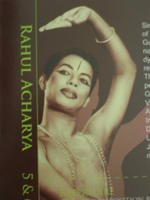
The haze in Kuala Lumpur hid all the stars but one. India-based Odissi dancer Rahul Acharya shimmered on Amphi-Sutra at Sutra Dance Theatre’s Under the Stars 2005: A Season of Odissi last week.
Rahul performed a six-part solo repertoire – Penetrating the Rasa – composed by Guru Shri Durga Charan Ranbir, an important guru of the school, or parampara, of the late Guru Deba Prasad Das.
In Mangalacharan Shiva Charanamrita, the invocatory piece, Rahul offers flowers to Bumi, or Mother Earth, and pays homage to Lord Siva.
Sthai is a forte of Deba Prasad Odissi dance where dancers emulate the classical dance sculptures in Orissan temples. This outstanding choreography keeps to the strict style of Guru Deba Prasad but incorporates a new concept.
Usually, a Sthai would begin with a chowka (square positions), but instead, this choreography begins with Pranata, a phangi (a style representing a sculpture).
The Pranata can be identified by the infolded hands (palms together). While keeping that gesture constant, Rahul dove and manoeuvred his hands and body like a slippery fish.
The other main phangis are: Alasa – the body stretches out in all directions emulating a lady trying to break her laziness; Manjira – the thumb and forefinger are locked holding imaginary cymbals, while the arms are in hitting and swirling motions playing the instrument; Mardala – this is the drummer’s position where palms face the ground and hands are flexed.
The chowka marks the change from one phangi to another, while the tribanga (three bends of head, torso and hip) brought the “moving” sculptures to live.
Rahul feels and enjoys every movement in his body as he morphs into various sculptures. The constant changing of body weight and coming back to centre almost seemed easy.
Oriya Abhinaya – E Ghora Barasa Kale and Abhinaya – Mamiyam Chalita Vilokya are both expressive dance interpreting literature. The former interprets the composition of poet, Kabi Samrat Upendra Bhanja. Two protagonists, Anukula Nayaka (hero) and Prositabhartruka Nayika (heroine), are separated and the nayaka imagines how his nayika would miss him. The latter is based on an excerpt from Gita Govinda by medieval Orissan poet Jayadeva. In this unique rendition, it is Krishna who feels the pain of separation from Radha. Krishna is remorseful of his wanton ways and causing grief to Radha.
A member of the audience later asked Rahul: “How convinced were you of Krishna’s love for Radha?” If the abhinaya did not convince, his answer certainly did!
“In Gita Govinda, Krishna is not as important as Radha. In fact, Krishna asks for the lotus dust on Radha’s feet so that he can rub it on his head” replied Rahul. “It is also destined that Krishna and Radha belong to each other eternally.”
The pure dance item, Pallavi – Raga Shankaravaranam/Arabhi, was executed with tenderness and grace. In contrast, the concluding piece, Sivashtaka, was dynamic and masculine.
There are seven classes of Tandava (masculine stylisation) and Rahul dances the Kalasava Tandava, which is the toughest of the seven. With heavy foot accents and fearsome expression, Rahul was Siva at his fiercest, destroying creation.
Insofar as being the hotbed of Odissi in Malaysia, Sutra Dance Theatre (www.sutradancetheatre.com) has been successful in attracting and raising star-quality dancers.
No comments:
Post a Comment